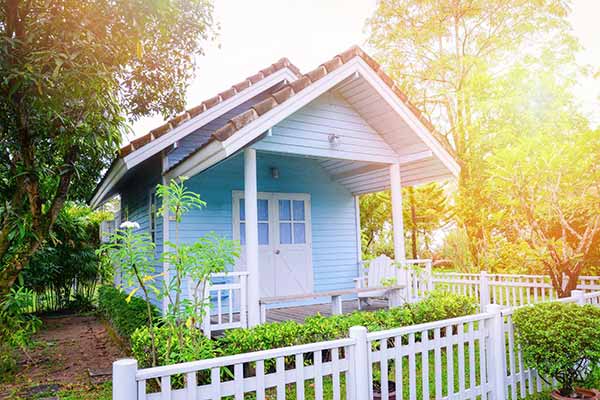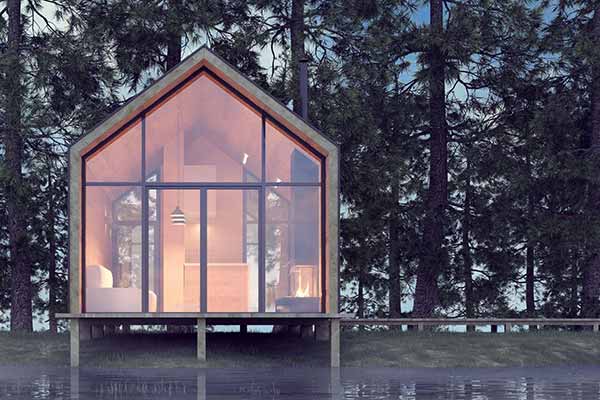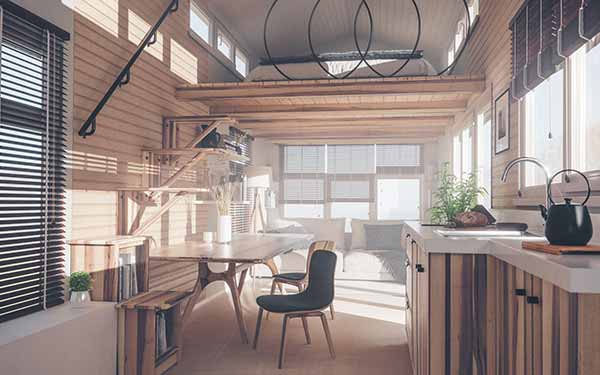Tiny houses are getting big press these days as more and more people are opting for tiny house living.
The reasons for making a small house your dream home are numerous, ranging from saving money on everything from building or buying your tiny home to furnishing it and managing it. The growing trend toward downsizing is rooted in wanting to live a minimalist and economical lifestyle that also reduces one’s environmental footprint.
If you’ve ever dreamed of going off-grid and living in a tiny house, you’re not alone. Economists predict a 6.25% market growth in North America, reaching $5.8 billion by 2024, with the majority of those buyers being millennials and baby boomers. It’s mostly due to economic concerns, increasing concerns over climate change, and more folks opting to move out of urban areas on the heels of the pandemic.
If you’re looking to buy or build your first tiny house, you may have a lot of questions or concerns about the legality of building a tiny home, what the benefits are, and whether or not it’s the right choice for you. Join us as we answer some of the most pressing questions for potential tiny homeowners.
What Are the Benefits of Living In a Tiny House?
There are dozens of benefits to living tiny, but perhaps the biggest is the savings. Still, beyond saving money and time, tiny living can be good for the soul.
Tiny House Living Can Save You Time and Money
Living in a tiny home saves time and money in numerous ways.
- You may save money on a mortgage payment; 68% of tiny homeowners do not have a mortgage compared to less than 30% of all homeowners in the United States.
- Tiny houses, on average, cost around $23,000 versus standard homes at just under $280,000. Tiny houses may be less expensive to build, but be careful, they can be more challenging to finance.
- Homeowner‘s insurance and taxes are based on home values, so that means that those who live tiny tend to save big when it comes to those two inescapable costs.
- Heating and cooling bills tend to be lower than those for larger homes — there simply isn’t as much space to keep cool or warm.
- There is little room to accumulate things (the average tiny home is 186 square feet), so tiny homeowners tend to think twice before buying stuff they don’t need.
- Living small means buying just what you need at the grocery store rather than loading up your carts because there’s less pantry space and sometimes smaller refrigerators.
- Cleaning tends to go faster as there is less space to accumulate grime, dust, and clutter.
- Many believe and adopting a minimalist lifestyle can help you clear your mind, feel calmer and in control, live with greater intention, and tread more lightly on the planet. and adopting a minimalist lifestyle can help you clear your mind, feel calmer and in control, live with greater intention, and tread more lightly on the planet.
Living Tiny Can Lower Your Carbon Footprint
Many of the time and money-saving benefits that you get from owning a tiny home also lead to lowering your carbon footprint since tiny houses use less energy for heating and cooling, produce less waste, and consume fewer resources.
In addition, when you buy fewer things, you reduce your impact on the environment by contributing less plastic, fewer used or broken electronics, and other non-biodegradable garbage that negatively impacts the planet.
Tiny Homes Offer a Better Quality of Life
Many tiny homeowners say their quality of life improved when they let go of their things and began living a minimalist lifestyle. The stressors of having a mortgage, maintaining a standard-sized home, and credit card debt due to needless spending are often removed when folks opt for tiny living.
How Much Energy Does a Tiny House Use?
According to Energy Star, the average household spends over $2,000 per year on utilities. That’s nearly $170 a month. Of course, tiny houses use less energy than that as there simply isn’t as much space to heat and cool. By comparison, tiny homes use about 7% of the amount of energy it takes to power electricity for an average size house.
How Can I Make My Tiny House Even More Energy Efficient?
Tiny home living can significantly slash energy costs, but that doesn’t mean there isn’t room to do better. Just as with standard homes, owners of tiny homes can make energy-efficient home improvements to make their little abodes more eco-friendly (and budget-friendly).
Solar Panels
Fifteen solar panels will typically power a tiny house, however, not all of them will fit on a tiny roof. If you want to power your home entirely with solar, you’ll likely need to place the rest of your panels on a ground structure.
On-Demand Propane
Many tiny houses use propane to heat water on demand. Likewise, sometimes propane is used for cooking and for space heaters, as the house is so small that it doesn’t require central heating or an HVAC system. A tiny home could use up to 500 gallons of propane a year.
Add Windows
Windows are key to tiny home living as they not only give a feeling of open space, but they are also great for ventilation. Large windows also facilitate passive heating and cooling. When air conditioning units are needed, many tiny home owners opt for window units or mini splits.
Are There Tiny House Communities?
There are numerous tiny house communities in the United States for small house parking. Some are combination RV parks and tiny home communities, while others are strictly one or the other.
Regardless of whether your tiny home is mobile or stationary, you’ll need someplace to put it. Many tiny life people prefer community living because it nourishes a sense of connection and camaraderie.
Fun Fact: There are also tiny house hotels where you can stay to get a feel for what tiny life might be like.
How Much Do Tiny Houses Cost?
It isn’t easy to give a definitive answer to the question of how much tiny houses cost. That’s because tiny homes can range from very simple and small to more extensive and fitted with quality amenities.
The median price of a tiny house is around $30,000, but they can cost as little as $2,000 or as much as $150,000 or more.
There are hundreds of tiny house builders as well as tiny homes for sale. Of course, you can go the DIY route and build a tiny home yourself if you’ve got the skills — doing so could save you a bundle in labor costs.
Tumbleweed tiny homes are among the most well-known, commercially available tiny houses. You can choose from a pre-existing floor plan and pick all your “trimmings,” or you can design your own and have them custom build it.
Are you dreaming about owning a tiny home and looking for ideas? HGTV has a great channel dedicated to the subject, covering everything from design to managing a tiny space with another person.
Can You Really Build a Tiny House for $2,000?
Yes, you can! There are small home blueprints and house models on the market that will allow you to build your own tiny house even if you’re on a tight budget with, say, around $2,000 to spend.
Likewise, you can purchase a tiny home kit for under $2,000 and then build the house yourself. Of course, less than $2,000 will get you very simple digs, but you can do it, and you’ll have a dry, warm place to rest your head at night.
Either of these options will require a DIY approach unless you have a wonderful construction worker who is willing to give you the buildout free of charge.
Keep in mind that hiring tiny house builders will definitely put you above that $2,000 price tag for your little dream home. That said, a DIY tiny house is an excellent place to start if you don’t have much cash and you really want to downsize and save.
Enter your ZIP Code and compare electricity rates
Do Tiny Houses Have Kitchens?
Some might say that the best tiny homes do have kitchens. However, others who are more minimalist may think that the best tiny homes have the very basics that will just get you by when it comes to food preparation.
In addition to built-in kitchens, most tiny houses also have bedrooms (some in a loft), living areas, bathrooms, and cleverly designed storage spaces.
Many tiny houses have wheels so that their owners can tow their houses around the countryside in a nomadic lifestyle. If that isn’t the case, it may be because the house started as a shipping container, bus, or similar and was later converted into lodgings.
Still, others are built on a foundation and stay in one place. Tiny houses that aren’t intended to be mobile often boast pretty porches, gardens, and perhaps even out-buildings that are used for storage, studios, and offices.
Tiny homes have kitchens and many of the other conveniences that a standard house would have. That is, if you want them to. Many tiny homeowners love that they can get really creative when it comes to designing their dream home.
What Is the Smallest Size for a Tiny House?
You may be wondering how many square feet a tiny house must be to be considered “tiny.” Tiny homes average 400 square feet or fewer.
Keeping in mind that not all states, counties, or cities are “tiny house friendly,” it’s important to remember that some ordinances require that a dwelling must be at least 1,000 square feet to be considered a residential dwelling.
Be sure to do your research before you decide on an area to build or bring your tiny house to life. Such ordinances can make a big difference when it comes to taxes and insurance for your home.
Are Tiny Houses Illegal in Some States?
Some states are more “tiny house friendly” than others. But it’s far more complicated than that. For example, many states may not have legal restrictions around tiny homes, but their counties or cities might.
Some places see tiny homes as unacceptable types of residences because of zoning laws and safety regulations.
Electricity, plumbing, and waste are all considerations when it comes to getting the right permits to live in your cozy casita.
Different areas will likely have different regulations. In some communities, the sustainability aspect of tiny homes makes them more desirable. Other municipalities or neighborhoods may consider them a threat to property values or even a safety hazard.
All that considered, it doesn’t seem as though tiny houses are explicitly forbidden in any state.
States that are more tiny house friendly tend to be more eco-conscious, or they are states where zoning laws and permits are a bit more flexible.
For example, Colorado regulators have removed stairway regulations, let go of the minimum square footage required for a home to be considered residential, and reduced the size requirements for exit doors.
The following are tiny home friendly states:
- Arizona
- California
- Colorado
- Florida
- Georgia
- Idaho
- Indiana
- Kansas
- Maine
- Massachusetts
- Michigan
- Minnesota
- Nebraska
- Nevada
- New Hampshire
- New Mexico
- New York
- North Carolina
- Oregon
- Pennsylvania
- South Carolina
- South Dakota
- Tennessee
- Texas
- Utah
- Vermont
- Washington
Of those listed above, the states that Business Insider says are the most popular for tiny home living are Arizona, California, Colorado, Florida, Oregon, New York, North Carolina, Texas, and Washington.
Some people with tiny homes on wheels decide to register their homes as recreation vehicles (RVs). However, bear in mind that if you go this route, you may have a hard time making it a permanent residential home if you decide to stay somewhere permanently.
Tiny Living Comes with a Big Impact
It’s a big decision to embrace tiny living. But it’s one that comes with a variety of potential benefits. You’ll reduce your carbon footprint, you’ll likely save money (especially on energy costs), and you’ll let go of the clutter in your life that may be taking up more space than is healthy. Whatever you choose, we hope this guide helped make the process a bit clearer.
Brought to you by energysavings.com
All images licensed from Adobe Stock.
Featured image:



